At first I’m sure it’s about the World Cup. Five water-skiers glide around the Mediterranean bay off Juan-les-Pins, where Philippe and I dine at a favourite beach restaurant. A single speedboat tows four skiers in a row, while the fifth stands on the shoulders of the middle two. Among them they wave three French flags.

Beauty and athleticism roll into one, with a French twist as the setting sun blazes through the fluttering bleu-blanc-rouges. What a spectacular way to celebrate France getting through to the quarter-finals!
Twilight dims into night, and with the arrival our main plates, a parade of pleasure boats floats into the bay. Each vessel is strung with glowing lanterns that cast long rays toward us over the waters.
That’s when we tweak. These performances have nothing to do with football. The same sort of procession happened last night on the other side of the Cap d’Antibes, in the bay right beneath our Bellevue. Members of the local Port de la Salis formed a défilé nautique aux lampions (a nautical parade with small lamps) as part of the city’s annual Fêtes de la St. Pierre, a three-day festival celebrating the patron saint of fishermen.
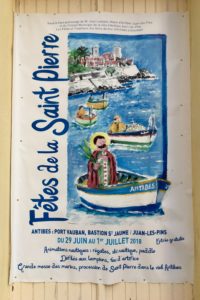
Judy mentioned these Fêtes to me last week. My American friend has lived in Antibes about as long as we’ve been coming here, and if you ask me, the town should appoint her as Director of Fun. This festival would include boat parades and fireworks, Judy told me, and a parade of St. Pierre’s statue through the streets of the old town.
As the illuminated boat parade makes its final tour of the bay, Philippe chats with our young waitress. “Donc, dites-moi,” he says, “Connaissez-vous les Fêtes de la St. Pierre?”
Non, she hasn’t heard of the festival.
Philippe nudges her. “You know, the patron saint of pêcheurs – the reason we have all these boats and fireworks ce weekend?”
“In my community,” she says, “there’s the Fête de St. Jean. That’s the big one.”
“St. Jean-Baptiste!” Philippe says. “Le 24 juin! The 24thof June! That’s the big one in Quebec, too.”
Different places favour different saints, and for the seaside towns of Antibes and Juan-les-Pins, the saint watching over fishermen is one that matters. The fact that these festivals even continue, though, is curious. France has one of the lowest rates of regular church attendance in the world, but the institution remains important for marriages, funerals, and – whether for reasons of faith or tradition – the fêtes of saints.
I send a text to Judy the next morning. “Have you done anything for St. Pierre?”
“I saw the fireworks and heard the parade this morning,” Judy writes back, ever the source. “I have a pic of this morning’s Gerbe à la mer au depart du port d’Antibes.”
My friend’s apartment overlooks Plage de la Gravette, the sandy beach beside Antibes’ old town. She sends over a few photos, including one of this morning’s gerbe. I have to look this word up. Shower. In this context, it’s a shower in the sea at the departure from Antibes’ port.
“What’s the gerbe à la mer?” I text back. “Something more than the usual morning dip?”
“I actually have no idea,” she writes. “I just copied the words from the program.” Philippe later tells me the gerbe is a long-held tradition where the faithful throw bouquets into the sea, but for the moment, we are clueless. “If you zoom in on the photo,” Judy says, “you can sort of see the boat has a statue on it.”
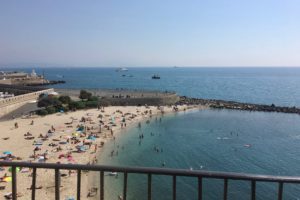
With my thumb and index finger, I try to enlarge the motorboats behind La Gravette’s break wall. Everything turns fuzzy.
Judy’s text continues. “I think the boat was carrying the Virgin Mary to I guess Port de la Salis, so they can carry her up to the lighthouse?” She adds, “I am unclear on the details and frankly just making stuff up here!”
I laugh. Judy’s “making stuff up here” tosses two different fêtes into the same pot. We’re talking about St. Pierre – but shortly Antibes will celebrate an altogether separate religious festival involving a different statue.
The first time I witnessed this other event, I swore some illustrious French manifestation (demonstration) was marching straight onto Bellevue’s doorstep. Early one Sunday morning a dozen years ago, I woke to the swelling cadence of a bass drum. Dum-dum-da-da-dum. Dum-dum-da-da-dum. From the bedroom window I saw a crowd of a hundred stride along Antibes’ seaside road to the incessant drumbeat. A few people waved banners, but the movement was orderly, and people carried themselves with striking unity and solemnity, even as they blocked the route out of town.
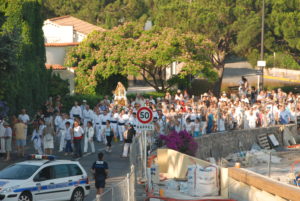
Dum-dum-da-da-dum. The cadence grew louder as the crowd reached the sandy beaches near Bellevue. From our small, portside balcony I could discern the form of a statue floating above the throng. The leaders stopped outside the Port de la Salis, where the pack folded into one other like an accordion. The drumbeat stopped. The statue, I now could see, was that of Mary and the Christ child; both wore crowns of gold. The breeze carried strains of a male voice addressing the crowd. After a brief pause, the ranks squeezed together with quiet purpose and disappeared into the rugged corridor of the Chemin du Calvaire, a 16th-century pathway that mounts the Cap d’Antibes.
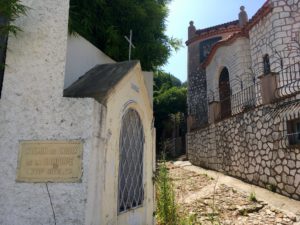
Before long, I learned that I’d witnessed the annual rite in which Notre-Dame-du-Bon-Port, the protector of sailors, returns from her short, celebratory visit in Antibes’ cathedral to her habitual home on the Cap d’Antibes. Those carrying the statue were sailors, and as tradition has it, they trekked that craggy pathway in their bare feet.
When (donning a good pair of hiking shoes) I made my own trek up the Chemin du Calvaire, I discovered a startling plaque on the exterior wall of the Chappelle de la Garoupe, the hulking, stucco chapel at the crest of the Cap d’Antibes. The last line of the inscription said, “981 – 1981.” This modern pilgrimage – one that my family has witnessed nearly every one of the past 12 years – has continued for over a millennium.
St. Pierre’s festivities this past weekend, then, have nothing to do with Notre-Dame-du-Bon-Port except for their shared interest in things maritime. And when the Mary statue does return back up the Cap d’Antibes’ hill, she will head to the chapel, not to the lighthouse, as Judy suggested. But as Philippe would say, let’s not let the facts get in the way of a good story.
Shortly local friends drop by to return Lolo from her soirée pyjamas (an altogether delightful way to label a “sleepover”). My daughter and theirs will hang out this afternoon at Bellevue.
The programme is flexible, I tell our friends, but I want to be here at 5:00 p.m. for the start of the rowing race from the port – you know, for les Fêtes de la St. Pierre.
Their faces are blank. Is it my French?
I reconsider. “You know les Fête de la St. Pierre?”
“That’s the one where they carry the statue up to the Garoupe?”
I cannot blame them. I’m no wiser about Toronto’s festivals – and at least they don’t mention a lighthouse.
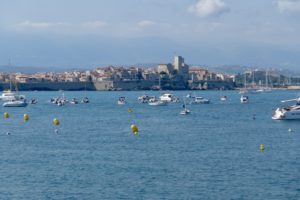
Activity grows at the local port as the afternoon draws on, and just before 5:00, several pointus (traditional, wooden fishing boats) file into the bay. Even more powerboats follow, their occupants ready to cheer on the rowers. Supporters gather on the quay. I spot a pair of binoculars. Soon the starting line dismantles itself and begins to circumnavigate Antibes’ rampart walls in the direction of La Gravette. I know Judy will be watching on the other side.
This coming Sunday morning, bright and early, I’m looking forward to that familiar cadence – dum-dum-da-da-dum – filtering through Bellevue’s shuttered windows. It’s part of the rhythm of local life we’ve grown to appreciate. Our town’s customs endure right before our eyes – even if I wonder how many people really understand them.
This time, though, I’ll be certain of one thing. All the hoop-la will have nothing to do with France’s promotion into the semi-finals.

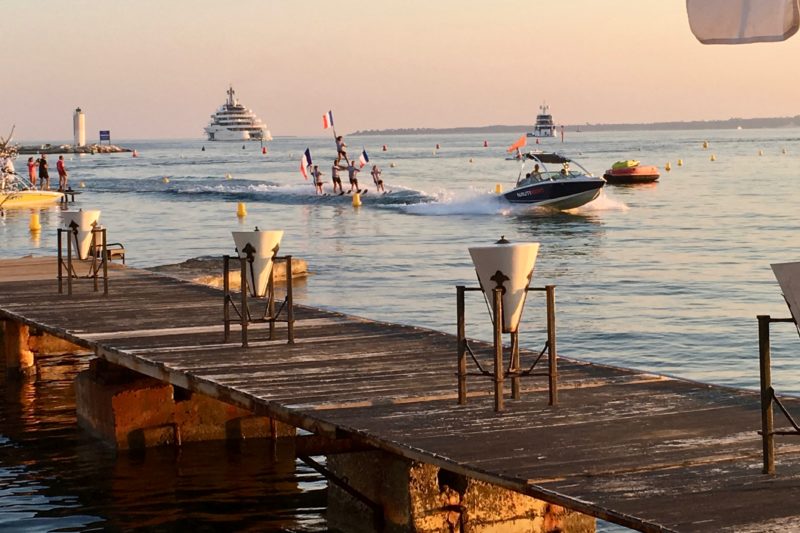
I wonder how many of us miss this each year? Thanks for this detailed … and entertaining, as always … account!
We were in Montreal for St. Jean-Baptiste Day and we were thinking it was celebrated only in Canada. Now we know the “real truth,” thanks to you.
Thanks for these vivid reminders of my family’s six wonderful years in the south of France! I actually attach spiritual significance to these Saints who blessed this country and its fascinating people. Royce.
You’re right, Royce. Your insights always humble me. Merci.
One has to love these old traditions of celebrating the saint even if no one remembers why they are celebrated. At least the ones in Antibes are less dangerous than the celebration of San Fermin in Spain which was also this week…the running of the bulls in Pamplona.
Hello to Judy! The Director of Fun, indeed!!! And I think I’m finally caught up on all the frenchlessons 2018, at last…
Thanks for such a vivid description of fun and rich French tradition!
Loved reading about these spiritual celebrations with appreciation of your investigative skills:) …Merci bien!